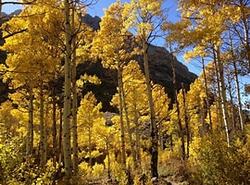Aspen
Common name: American Aspen, Quaking Aspen, Trembling Aspen
Scientific Name: Populus tremulloides
Where does it grow: A wide area across the northern United States and into Canada
How tall does the tree grow: up to 50 feet tall with a spread of 20 to 30 feet at maturity
Tree trunk diameter: from 8 inches to 2 feet 7 inches
Color of lumber: whiteish, creamy grey to grey brown
Grain: fine grained, uniform in texture, generally no distinctive pattern
Janka Hardness: 350 (soft)
Cost: Just over $4 a board foot (December 1, 2021)
Notes: Can be used as an alternative to holly for intarsia projects. American Aspen trees are easily recognized by their flat, paper thin leaves that give off a shimmering appearance (hence the names “quaking” and “trembling” aspen). Aspen trees grow in groves with a shared root system.
Woods that are grouped into the scientific genus of “populus” include cottonwood, aspen and poplar. This is a bit misleading since here in the US, the wood we refer to as “poplar” is Yellow Poplar, which isn’t really a poplar at all (it is a scientifically unrelated hardwood that has similar characteristics called liriodendron tulipifera).
Scientific Name: Populus tremulloides
Where does it grow: A wide area across the northern United States and into Canada
How tall does the tree grow: up to 50 feet tall with a spread of 20 to 30 feet at maturity
Tree trunk diameter: from 8 inches to 2 feet 7 inches
Color of lumber: whiteish, creamy grey to grey brown
Grain: fine grained, uniform in texture, generally no distinctive pattern
Janka Hardness: 350 (soft)
Cost: Just over $4 a board foot (December 1, 2021)
Notes: Can be used as an alternative to holly for intarsia projects. American Aspen trees are easily recognized by their flat, paper thin leaves that give off a shimmering appearance (hence the names “quaking” and “trembling” aspen). Aspen trees grow in groves with a shared root system.
Woods that are grouped into the scientific genus of “populus” include cottonwood, aspen and poplar. This is a bit misleading since here in the US, the wood we refer to as “poplar” is Yellow Poplar, which isn’t really a poplar at all (it is a scientifically unrelated hardwood that has similar characteristics called liriodendron tulipifera).

